Biolaminin 521 LN (LN521)
Human recombinant laminin 521
Biolaminin 521 LN is the natural laminin for pluripotent stem cells, reliably facilitating the self-renewal of human ES and iPS cells in a chemically defined, feeder-free, and animal origin-free stem cell culture system. Biolaminin 521 enables efficient single-cell passaging of genetically stable and pluripotent stem cells without the need for any apoptosis inhibitors, ensuring superior quality for your cells and studies.
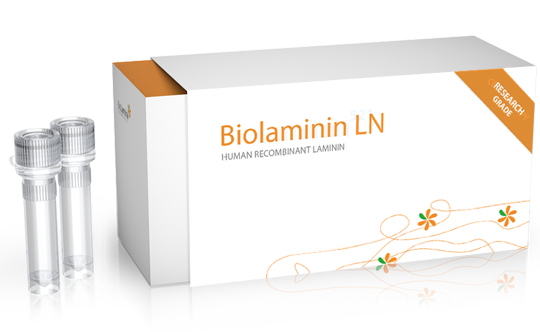
The only full-length laminin proteins on the market
Biolaminin 521 LN (LN521-02 and LN521-05) comprises full-length, human recombinant laminin-521 protein, designed for feeder-free cultivation of human pluripotent stem cells (hPSCs). As an inherent stem cell niche protein, laminin-521 provides a biologically relevant environment leading to improved survival and efficient growth from single-cell cultures to large-scale production.
A robust and long-term stem cell culture
By replicating the native hPSC microenvironment, the Biolaminin 521 substrate facilitates optimal attachment, high survival rates, and sustained self-renewal of pluripotent stem cells in vitro.
Laminin-521 standardizes pluripotent gene expression profiles, maximizes genetic stability, and activates pertinent cell signaling pathways, ensuring uniform cellular responses and improved functionality.
Streamlined differentiation with tissue-specific laminin
Beyond its fundamental role in sustaining stem cell cultures, laminin-521 also augments cell maturation in differentiation protocols, fostering the maturation, polarization, and organization of specialized cell types. It stands as the preferred option for culturing a set of primary cell types given its natural occurrence in tissues such as the nervous system, pancreas, and eye.
From research to clinical use
Are you aiming for clinical applications? The cell therapy grade laminin-521 product Biolaminin 521 CT is designed for translation with extensive regulatory documentation.

Recommended applications
-
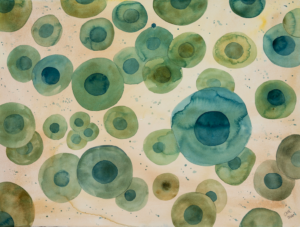
Pluripotent stem cells
Biorelevant culture of human ES and iPS cells on Biolaminin substrates Biolaminin 521 successfully replicates the genuine human stem cell niche […]View application -

Clonal stem cell culture
Biorelevant clonal stem cell culture on Biolaminin substrates Biolaminin 521 successfully replicates the genuine human stem cell niche in vitro […]View application -
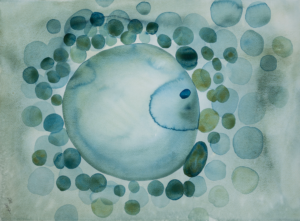
iPSC reprogramming and expansion
Reprogramming and expansion of human iPS cells on Biolaminin substrates High-efficiency iPSC reprogramming and expansion on Biolaminin 521 Human recombinant Biolaminin […]View application -

Skin cells
Biorelevant culture of keratinocytes on Biolaminin substrates The basement membrane composition in the epidermis Human epidermal keratinocyte (HEK) cells are […]View application -

3D culture
Biosilk and Biolaminin key advantages 3D cell culture and organoid formation 3D culture systems for disease modeling, drug screening, and […]View application -

Hematopoietic stem cells and blood cells
Biorelevant culture of hematopoietic cells Laminins play a major role in the hematopoietic microenvironment Laminins are widely expressed in human bone […]View application -
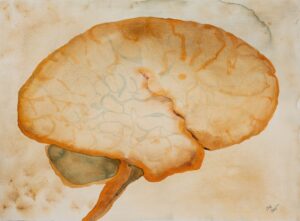
Neural cells
Biorelevant culture of neural cells on Biolaminin substrates Laminins are widely expressed in the nervous system and are essential for […]View application -

Hepatocytes and hepatoblasts
Biorelevant culture of liver cells on Biolaminin substrates Several laminins play a vital role in liver progenitor cell-mediated regeneration The […]View application -
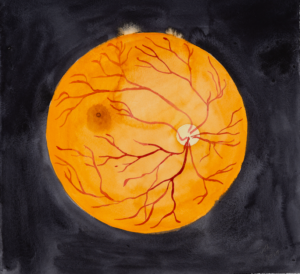
Eye cells
Biorelevant culture of eye cells Laminin proteins are important components in the eye microenvironment Biolaminin products have been succesfully used […]View application -

Endothelial cells
Biorelevant culture of endothelial cells Biolaminin isoforms for vascular endothelial cell culture Endothelial cells that make up the vascular network […]View application
Key features
Key benefits
Biological relevance

Laminin 521 is a key cell adhesion protein of the natural stem cell niche, expressed and secreted by hPSCs in the inner cell mass of the embryo. LN521 recreates the biologically relevant milieu in vitro and therefore supports the robust expansion of human ES and iPS cells.
Easy and flexible protocols

- Coat plates with LN521.
- Wash the cells with PBS and add dissociation reagent of choice.
- Centrifuge the single-cell suspension and resuspend the pellet in a fresh medium of choice
- Seed as a single-cell suspension on fresh LN521 coated plates
The single-cell split is easy, fast and forgiving, making anyone suitable to culture hPSCs. When using LN521, your cell culture protocol can easily be made totally defined and animal origin-free with your choice of culture medium and dissociation reagent. For reduced labor and cost, the LN521 matrix supports weekend-free feeding.
Cost-effective stem cell culturing

The specific LN521 binding of the α6β1 integrin enables high cell survival and self-renewal and hPSCs grow faster on LN521 compared to other feeder-free matrices. Due to faster growth rate and higher cell yield, the total cost (medium and matrix) per cell for an average passage is lowest for LN521.
Long-term efficient expansion
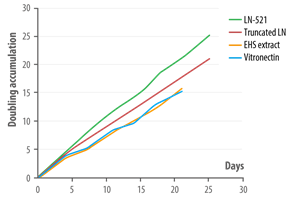
hESC and iPSC grow faster on LN521 compared to other feeder-free matrices, facilitating automation. The specific LN521 binding of the α6β1 integrin enables high cell survival and self-renewal. Cells expand quickly and reach 100% confluency after only 4 days after a 1:10 split. You will thus have 10.000 fold more cells after only 4 passages, making the cell quantities of low-passage hPSCs needed for clinical applications possible.
Genetic stability
With LN521 hPSCs can be seeded as single cells at low densities and cultured long-term without the introduction of genetic abnormalities. Cells have been kept on LN521 for more than 130 passages with stable karyotypes. Importantly, when LN521 is used for the derivation of new hESC lines, the embryo is not destroyed and the lines originating from a single blastomere are genetically stable.
Homogenous hPSC monolayer
PSCs plated as a single-cell suspension on LN521 grow as a homogenous monolayer without any abnormal genetic aberrations. The specific LN521 binding of the α6β1 integrin enables high cell survival and self-renewal and once adapted to the LN521 matrix, hPSCs can routinely be cultured as single cells without the addition of ROCKi. LN521 also supports clonal survival and is a good substrate for derivation and gene editing.
Homogenous and stable pluripotent gene expression
Culture on LN521 significantly reduced the variation of pluripotency marker expression compared to culture on hFFs (fibroblasts). Moreover, hES cells cultured on LN521 are more homogenous, attached better and grew faster compared to hES cells cultured on other substrates. hPSCs can be cultured to near confluence on LN521 without spontaneous differentiation and there is no need to remove differentiated cell areas. LN521 has a homogenizing and stabilizing effect on pluripotent gene expression profiles between hES cell lines and provides the first step towards generating more controllable, robust and clinically safe culture conditions.
hPSC culture on LN521
The instructions include recommendations for transfer, passaging, thawing, and cryopreservation of hPSCs on LN521.
Embryoid body formation
Important notes
- “For Research Use Only”
- All procedures should be done under sterile conditions using aseptic techniques
- Avoid long exposure of the protein to ambient temperatures
- The laminin stock solution is long-term stable when stored at -20°C to -80°C. Please refer to the product-specific CoA for shelf life details.
- Repeated freeze-thawing should be avoided. If desired, the laminin stock can be dispensed into working aliquots and stored at -20°C to -80°C. Thawed, undiluted laminin stock is stable for at least 3 months when stored at +2°C to +8°C under aseptic conditions.
- Avoid long exposure of the protein to ambient temperatures.
- For your convenience, the coated plates can be kept for up to 4 weeks when stored aseptically at +2°C to +8°C.
- The protocols can easily be made totally defined and animal component-free with your choice of culture medium and dissociation reagent
- It is important that the cells transferred to the LN521 matrix are of high quality.
- Some hPSC lines transferred to the LN521 matrix, might require an adaptation period before they can be cultured according to the single-cell passaging protocol.
- Once adapted to the LN521 matrix, hPSCs can routinely be cultured as single cells without ROCKi.
- The LN521 matrix facilitates long-term self-renewal of hPSC without weekend feeding.
Troubleshooting
Biolaminin plate coating
An uneven cell spread is often a coating issue and could be caused by the following:
- Too low coating concentration used. Increase the coating concentration is high enough to support even cell growth.
- Bad coating coverage/the plate has dried out. Ensure that the entire surface is covered by the laminin coating solution when preparing fresh plates. Also, do not let the plate dry out as this will inactivate the laminin coating. Too long time in the incubator or long storage without sealing could cause too much evaporation so that part of the plate dries out (often in the center).
hPSC splitting and seeding
- We recommend single-cell passage or passage as small clumps.
- Stem cells are sensitive and when using an enzyme, do not treat the cells too long as that will damage the cells. Cells attach tighter on laminin compared to other matrices and scraping or pipetting without first loose up cells can affect cell integrity and viability which could result in less attachment the next day. Less confluent cells need shorter treatment time whereas more confluent cells might need longer treatment time. The cells should detach easily without too much pipetting needed. Do not use too much mechanical force (extensive pipetting or scraping) as that will damage the cells. Increase the dissociation reagent incubation time rather than increasing the force. If the cells stick very hard to the LN521 surface, try to lower the coating concentration.
- After seeding: most cells should have attached after 1 hour and the cells should be evenly distributed over the entire plate. If there is a lot of cell death after seeding, the cells have most likely been treated too harshly during splitting.
- The day after seeding: the cell has migrated and should have formed small colonies and will continue to expand as a homogenous monolayer. Cells cultured on the LN521 matrix are ready to be passaged when cell culture is 60-99% confluent. Depending on the cell line, seeding density and on the medium used, cultures are usually passaged 3-6 days after seeding.
Product name
Biolaminin 521 LN
Product code
LN521
Declaration
For research use only
Storage
-20°C to -80°C
Concentration
0.1 mg/ml
Appearance
Clear, colorless, buffered solution with a pH of 7.2 with 10% glycerol and 0.02% NaN3
Shipping condition
Dry Ice
Protein name
Laminin 521 (Laminin-11)
Classification
Animal origin-free, human recombinant protein
Product application
Culture of human embryonic and induced pluripotent stem cells (hESC and hiPSC), mesenchymal stem cells (MSC) and most anchorage-dependent progenitor cell types. Differentiation and maintenance of specialized cells, such as hepatocytes, cardiomyocytes, and neurons.
Clonal culturing of human embryonic stem cells on laminin-521/E-cadherin matrix in defined and xeno-free environment
Rodin S., Antonsson L., Niaudet C., Simonson O.E., Salmela E., Hansson E.M., Domogatskaya A., Xiao Z., Damdimopoulou P., Sheikhi M., Inzunza J., Nilsson A.S., Baker D., Kuiper R., Sun Y., Blennow E., Nordenskjöld M., Grinnemo K.H., Kere J., Betsholtz C., Hovatta O., Tryggvason K.
Nature Communications, 2014
Monolayer culturing and cloning of human pluripotent stem cells on laminin-521 based matrices under xeno-free and chemically defined conditions
Rodin S., Antonsson L., Hovatta O., Tryggvason K.
Nature Protocols, 2014
a-5 Laminin Synthesized by Human Pluripotent Stem Cells Promotes Self-Renewal
Laperle A., Hsiao C., Lampe M., Mortier J., Saha K., Palecek S.P., and Masters K.S.
Stem Cell Reports, 2015
A defined xeno-free and feeder-free culture system for the derivation, expansion and direct differentiation of transgene-free patient-specific induced pluripotent stem cells
Hong Fang Lu, Chou Chai, Tze Chiun Lim, Meng Fatt Leong, Jia Kai Lim, Shujun Gao, Kah Leong Lim, Andrew C.A. Wan.
Biomaterials, 2014
Laminin 521 stabilizes the pluripotency expression pattern of human embryonic stem cells initially derived on feeder cells
Albalushi H., Kurek M., Karlsson L., Landreh L., Rós Kjartansdóttir K., Söder O., Hovatta O., Stukenborg J-B.
Stem Cell International, 2017
Niche-derived laminin-511 promotes midbrain dopaminergic neuron survival and differentiation through YAP
Zhang D., Yang S., Toledo E.M., Gyllborg D., Saltó C., Villaescusa J.C., Arenas E.
Sci Signal. 2017
Optimization of slow cooling cryopreservation for human pluripotent stem cells
Takamichi Miyazaki, Norio Nakatsuji & Hirofumi Suemori.
Genesis, 2013
Xeno-free culture of human pluripotent stem cells
Bergström R, Ström S, Holm F, Feki A, Hovatta O
Methods Mol Biol, 2011
Size guide
Not sure how much laminin you need? To make it easy, we have created a tool where you can calculate the amount needed for your experiments. Just choose culture well format and fill in the desired coating concentration to see the amount required.